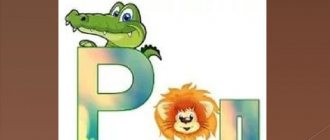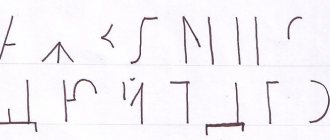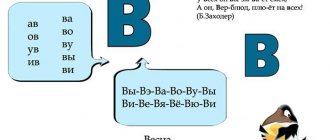Distinguishing the pronunciation of sounds in the absence of sound replacement
- First practice pronouncing that defective sound that the child used to have. You pronounce the words the way the child pronounced them before (that is, pronouncing the sound incorrectly), then correctly (sometimes vice versa). The child “guesses” when you pronounced the word correctly.
- The child must first pronounce words correctly, then the same way he pronounced them before (sometimes vice versa). You "guess" when he said it correctly and when he didn't. From time to time you will “make mistakes” (confuse correctly and incorrectly pronounced words), and the child must detect and correct these mistakes of yours.
- You pronounce the word the way the child used to pronounce it. He must “correct” your pronunciation - pronounce the word correctly.
- You pronounce a word correctly, and the child must repeat it after you the way he pronounced it before (defectively), and then “correct” his pronunciation.
- The child must first pronounce the word correctly, then the way he pronounced it before (defectively), then again correctly.
Distinguishing the pronunciation of sounds when replacing sounds
The work of distinguishing sounds will be described using the example of the sounds [s] and [w]. Expected situation: instead of the sound [w], the child pronounced the sound [s]. Pre-familiarize your child with the corresponding letters. Other symbols can be used: for example, the sound [s] (old pronunciation) may be indicated by a black circle, and the sound [w] (new pronunciation) may be indicated by a red circle.
Differentiation of sounds in an isolated position. When you show your child the letters [s] or [sh] (or symbols that replace them), he should pronounce the corresponding sounds.
Differentiation of sounds in syllables. You pronounce syllables very slowly, among which there are syllables with the sounds [s] and [sh], [ra], [shi], [lo], [su], [re], [sha], etc. Bogda child hears one of the differentiated sounds, he must show you a picture with the corresponding letter and name the sound that he heard.
Differentiation of sounds in words.
- You slowly pronounce words where the sounds [s] or [w] are at the beginning of the word (garden, son, fur coat, sleep, step, etc.), the child must name the sound with which the word begins. Make sure that you do not alternate words first with one sound, then with another, in this case the child will stop paying attention to the verbal material and will simply begin to raise his hand through the word.
- You pronounce simple words where the sounds [s] or [w] are in the middle of the word: porridge, braid, mustache, soul, ears, fox, etc. The task for the child is the same as in the previous case.
- You pronounce simple words where the sounds [s] and [w] are at the end of the word: forest, ladle, fox, mouse, shower, cape, etc. The task is the same as in previous cases. Be sure to ensure that among the words there are no words in which both differentiated sounds are simultaneously present.
- The child must come up with words that begin with the sound [s] or [sh].
- You name pairs of words that differ from each other in only one sound ([s] or [sh]), for example: bowl - bear, koska - cat, helmet - porridge, cape - mouse, etc. Having named a pair of such words ( for example, a braid is a cat), you ask the child questions, for example: “What can be braided on a girl’s head?”, “Who says meow?” The child must answer your question using the correct word.
- The child should repeat after you words that contain both differentiated sounds at once: highway, land, boxwood, pole, etc.
- The child should repeat after you words in which there are both differentiated sounds (as in the previous exercise) and words in which the same sound occurs twice (for example: kebab, nipple, checkers, etc.). In the latter case, the child often replaces the repeated sound with another (for example: shashlik - sashlyk or shashlik, soska - fry or shoska, etc.).
Differentiation of sounds in sentences. The child should repeat after you sentences in which differentiated sounds occur in large numbers, including in one word: Sasha is walking along the highway. The cat ate the mouse. Boxwood grows in the garden.
Differentiation of sounds from pictures
- The child must arrange the pictures whose names contain the sounds sounds [c] [w] into two piles: one with the sound [s], the other with the sound [w].
- The child must choose from a bunch of pictures those whose names contain the sound [s] (among the pictures there should also be pictures whose names contain the sound [w]). Then from the same pile you need to select those pictures whose names contain the sound [w].
Example words for differentiating sounds
Words for differentiating sounds [s - w]: Sasha, highway, land, drying, six, pole, wool, nimbleness, duchess, fascist, procession, knuckle, rustle, boxwood, weightlifter, wasteland, eared, chance, shepherdess, machinist, hornet, kebab, checker, cone, nipple, sausage, gopher, samsa, swineherd, space. Words for differentiating sounds [z - zh]: rod, lighter, yellowness, life, clamp, ignition, iron, healing, makeup artist, zhizha, ground beetle, excitement, splinter, gap, sweetheart, arrogant, zrazy. Words for differentiating sounds [ts - s]: tank, citrus, kingdom, stairs, desert, hotel, station, specialist, sun, village, abscess, oyster, process, male, tsatsa, tsetse fly, concept, Cicero, queen, stanzas , Stae, pacifier, iconostasis. Words for differentiating sounds [l - r]: roll, eagles, throat, lorgnette, Lara, overlock, Karl, Clara, drill, caravel, coral, den, marmalade, carnival, Frol, flora, formula, casket, charlatan, corporal, emergency, rapier, spring, castling, Aurora, resort, bell, balalaika, scrap metal, puzzle. Words for differentiating sounds [l - i]: husky, bark, apple, Yalta, balalaika, pancakes, blanket, spinning top, Christmas tree, slide, puff pastry, Dalai Lama, Jamaica, egg, bell, puzzle. Words for differentiating sounds [l' - i]: ruler, watering can, spruce, lily, beehive, glue, train, alley, manger, sculptor, Julia, hookah, Leah, skiff, lithium, alliance, flute, rut, Jamaica, egg , Lilya, Lala. Words for differentiating sounds [p - i]: paradise, swarm, Paradise, brightness, fair, yoke, region, edge, cut, troika, Ermak, moira, saury, yurt, fireworks, Beirut. Words for differentiating sounds [p' - th]: prairie, reika, Korean, Yuri, Guria, aria, Maria, boyar, mayor's office, Austria, fury, remake, Friedrich, refrain, referent, scrape, secretary, crossroads. Words for differentiating sounds [р' - l']: solarium, malaria, cavalryman, April, cleric, coppice, pilgrim, grill, charm, lyrics, prel, tide, healer, binding, quail. Words for differentiating sounds [t' - h]: teacher, bird, flow, seal, mosque, buckshot, first aid kit, reading, quarter, chick, respect, shadow, aunt, bowstring, black grouse, dot, scarecrow, why, drawing, tap dance .
Let's together teach children to speak clearly and correctly, easily and beautifully!
Contained in sections:
- Letters. Getting to know letters and sounds 2733
- Speech therapy classes 9440
- Literacy training. Sounds, letters, syllables 9026
Includes sections:
- Differentiation, automation of sounds. Didactic games 385
- Sounds [L] - [R]. Differentiation of sounds 158
- Sounds [L], [L']. Automation, sound differentiation 708
- Sounds [S] - [SH]. Differentiation of sounds 443
By groups:
- Senior group
- Preparatory group
- Middle group
Showing publications 1-10 of 4048. All sections | Sound differentiation and automation
New
Photo
The best
Notes of the correctional speech therapy lesson “Differentiation of consonant sounds [s]-[w]” Notes of the correctional speech therapy lesson “ DIFFERENTIATION OF CONSONANT SOUNDS S-SH ”
Completed by teacher-speech therapist Farrakhova Inna Valerievna GOAL:
differentiation of sounds s-sh in syllables , words, phrases. OBJECTIVES: correctional and educational: to improve the ability to differentiate sounds s-sh in...
Notes of a correctional speech therapy lesson “Differentiation of consonant sounds [z]-[zh]” LESSONS OF A CORRECTIONAL Speech Therapy LESSON ON THE TOPIC “ DIFFERENTIATION OF CONSONANT SOUNDS Z-Z ”
Performed by teacher - speech therapist Farrakhova Inna Valerievna Purpose of the lesson:
differentiation of sounds [z] - [z] in syllables , words, phrases. Objectives: • correctional and educational: improve the ability...
Rules for differentiating sounds
- If the child did not have a replacement of sounds (for example, he pronounced the sound [w] as an unclear hissing sound or the sound [r] - with one beat), it is very advisable to distinguish his old pronunciation from the new one. This will allow the child to quickly “get rid of” the previous defective pronunciation.
- If the child did not pronounce any sounds (missed them in speech), the need to differentiate these sounds disappears by itself (there is nothing to differentiate).
- If a child replaced a sound with some other sound (for example, [w] was pronounced as [s], or [r] as [l]), these sounds must be differentiated in order to prevent the child from developing reading and writing disorders.
- You can begin to differentiate sounds after the child freely pronounces them in syllables following you by imitation.
To more quickly distinguish sounds, comparison of similar sounds by ear and pronunciation is of great importance.
In this case, the same games and exercises are used as when recognizing a separate sound in a word. Since games here are played simultaneously with two sounds, all symbols are doubled. Pictures or toys as symbols are placed in front of the children at a certain distance from each other (to make it easier to point to them with your hand), and the child holds the figures, one in each hand.
Games to develop the ability to differentiate oppositional sounds
1. “Where is the sound?” (an example of comparing the sounds S-Sh in different ways).
The child can:
a) show pictures, toys or objects: bag, hat;
b) answer with words: garden, fur coat;
c) use onomatopoeia: ssssss - pump, sh-sh-sh - steam locomotive;
d) imitate movements silently or accompanied by sounds (pump, steam locomotive);
e) name the actions - the cry of an animal, bird or the sound of an object:
whistles (whistle) - S, hisses (tire burst) - Sh;
f) use gestures: hand goes down - C (tongue down, behind the lower teeth); hand up - W (tongue rises up).
2. “Remember and repeat.”
The child remembers five to seven names of pictures with related sounds and repeats them in the same order after they are covered by the screen or turned over.
3. “Find what you need.” There are ten or more pictures on the table. The child selects from them only those whose names contain one of the related sounds.
4. “Divide by two.”
Children are asked to correctly name and arrange the pictures into two piles in accordance with the sounds being studied in any position.
5. “Divide by two and three.”
The child must arrange all the pictures into two piles, then each of them into three more parts in accordance with the position of the sound being studied in the word.
6. "Telegraph". The children memorize four words with oppositional sounds, four children take turns naming them one at a time, the fifth again starts with the first word. For example: shower - knock - oak - mascara - shower...
7. “What is it, repeat!”
Repeat words that differ in one sound and explain how they differ (in terms of sound composition and meaning: barrels - kidneys; in the first word we hear the sound B, and in the second - P; barrels are dishes, you can salt cabbage in them, and the buds bloom on the trees in the spring).
8. “Start from the end.” The child must repeat first the second and then the first word: kidneys - barrels.
9. “Change the sound.” For example, the word cod is suggested. The child replaces the dull sound with a voiced one and pronounces the resulting word: bunny (C-3).
10. “What came first?” The teacher pronounces two or one word with paired sounds. The child is asked to determine which one is heard first. For example: R—L, red varnish—R, kilometer—L.
11. “What then?” Which of the paired sounds is heard later? Tom - house - D.
12. “Name it in order.” For example: sweet sugar - L, R; fisherman - R, L.
13. “Start from the end.”
The child names the second and then the first of the required sounds. For example: tsok - juice - S, C.
14. “Finish the word” (pictures are shown). Sh—F: u-shi, lu-zha, ski-zhi, bag-shok.
15. “Listen to your neighbor.”
Children are given two pictures with paired sounds. The teacher, starting the game, pronounces a word with one of them and points to the child, who must name the word with a different sound, the next called child changes the sound again. The named drawings are turned over to the reverse side. The result is a chain of words with oppositional sounds, for example K-G: bow, leg, cat, goose, cancer, carriage, etc.
16. “Finish the sentence.” The game is played with and without pictures: Nails need... varnish. There lives... a crayfish in the river.
17. “Who is bigger?” Children, looking at the plot picture, select words with the sounds being studied in any order (you can alternate). For example, “Winter” (N-W): snowman, scarf, sled, fur coat, throws, mittens, snow, big...
18. “Remember the word.”
Children come up with words with given sounds without pictures.
Thus, the education of phonemic hearing and differentiated pronunciation of all sounds is aimed at developing in children the ability to perceive various subtleties of sound, correctly hear and use acoustically and articulatory close sounds in independent speech - without this knowledge, it is impossible to prepare children for mastering literacy.
Game progress: place passengers in carriages.
"Shop"
Material: large card divided into 3 strips (store shelves)
.
The stripes are drawn into squares, in which items of clothing, dishes, money are drawn - symbols of sounds .
Progress of the game: each child is given 6 squares with any one letter. With your own money you can buy those items whose names contain this sound . The one who spends his money faster wins.
Second option. Letter money lies on the table with the images down, each player takes one for himself and buys the corresponding product.
"Build a house"
Material: subject pictures on rectangles (bricks)
- for
differentiated sounds , on the large triangle (roof)
- a pocket for letters
(symbols
of sounds ) .
Progress of the game: build a house for the heroes, for example, for the Larisa doll, choosing only bricks whose pictures have the sound [L] , and for the robot Roma - with the sound [R] .
"Collect a flower"
Material: subject pictures on colored petals and letters (symbols of sounds )
on the round core of the flower.
Progress of the game: collect flowers by choosing petals with pictures for given sounds .
"Let's decorate the room with flags"
Material: two stretched ropes, object pictures (with differentiated sounds , pasted onto multi-colored flags.
Progress of the game: the teacher informs the child that a holiday is coming. In honor of the holiday, the speech therapist suggests decorating the office with flags with pictures, choosing only flags with pictures for the given sounds - on one string with the sound [C] , on the other with the sound [Z] .
"Let's decorate the Christmas tree"
Material: silhouettes of two Christmas trees (with pockets for symbols of sounds , on which small buttons are attached using wire, small circles with a loop of braid - “Christmas balls”
, on which subject pictures are glued.
Progress of the game: the teacher invites the child to decorate the Christmas tree with balls on which pictures with differentiated sounds , attaching the balls with a loop to the Christmas tree.
"Sun"
Material: subject pictures on yellow rectangles (rays)
and symbols
of differentiated sounds on yellow circles (2 suns)
.
Progress of the game: the teacher invites the child to collect rays for the sun, choosing only those whose names contain a given sound .
"Collect apples"
Material: subject pictures on apples made of green cardboard, 2 baskets with slots for symbols of sounds .
Progress of the game: the teacher says that the wind shook the apple tree and apples fell from it. It is necessary to collect apples in baskets. the sound [Z] on them , and in a dog’s basket you need to collect apples with pictures with the sound [S] . , “Collect the carrots” games are played.
,
“Pick the pears”
, etc.
"Make a pyramid"
Material: subject pictures pasted onto multi-colored rings of different sizes.
Progress of the game: the teacher invites the child to put together two pyramids of figures, choosing only those figures on which a picture with a given sound , for example, one pyramid with the sound [Ts] , the other - [H]. The child must fold the pyramid according to all the rules, selecting the rings in decreasing order. The shapes for the pyramid can be of the most varied shapes: ovals, rectangles, squares, trapezoids, etc.
"Give the doll some tea"
Material: subject pictures pasted onto colored cardboard cups, doll.
Progress of the game: the teacher introduces the child to the dolls Zhenya and Zina, telling them that they are very capricious - they like to drink tea only from cups on which pictures are drawn with their favorite sounds [F] and [Z] . Among the many cups, the speech therapist teacher asks you to find those with such pictures.
"Aquarium"
Material: two drawn aquariums with pockets (for symbols of sounds , multi-colored aquarium fish made of paper with object pictures glued on the reverse side for differentiated sounds .



